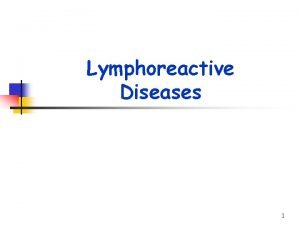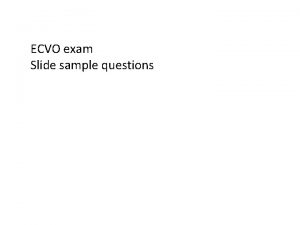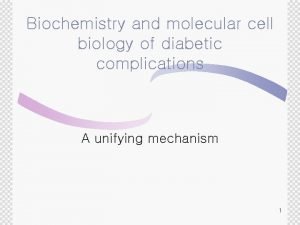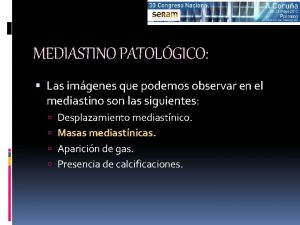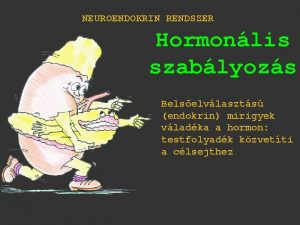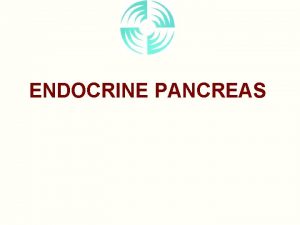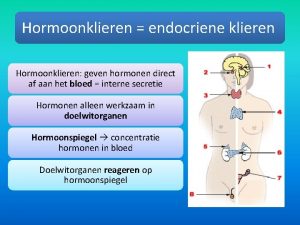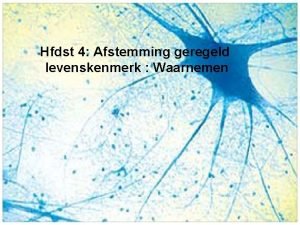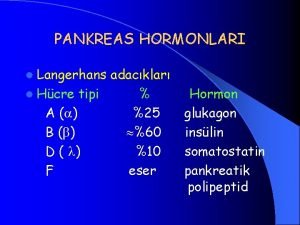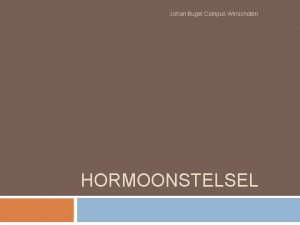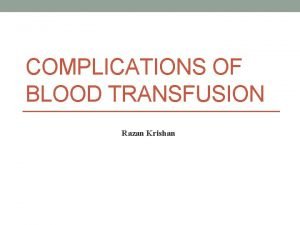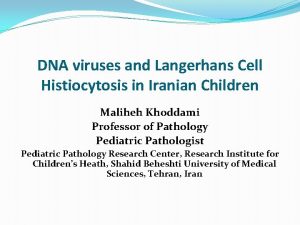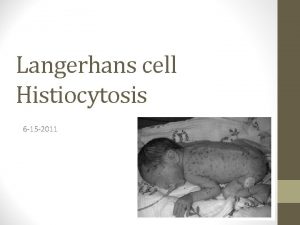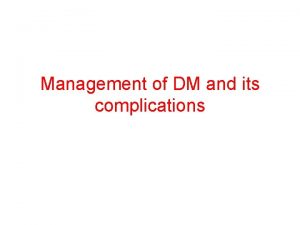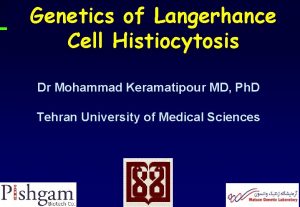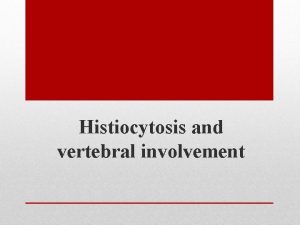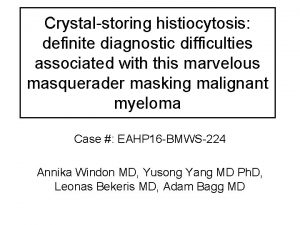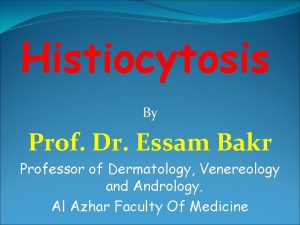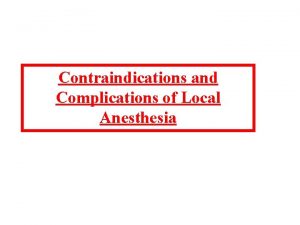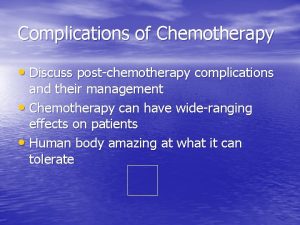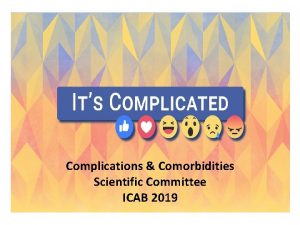Complications of Langerhans Cell Histiocytosis and its management





















- Slides: 21


Complications of Langerhans Cell Histiocytosis and its management By: Dr Mahdi Shahriari, Pediatric Hematologist Oncologist. Affiliation: Department of Pediatrics, Shiraz University of Medical Sciences, Shiraz, Iran. 11 th National congress of IPHOS, Kish Island

Background: Langerhans cell histiocytosis (LCH) is an inflammatory myeloid neoplasia characterized by the accumulation of clonal CD 207+ myeloid dendritic cells amidst an inflammatory background of macrophages, T lymphocytes, and eosinophils, with a wide range of clinical presentations. LCH occurs in 2 -10 per million children and 1 -2 per million adults per year, with extreme clinical heterogeneity.

Background: It can affect any organ system, but most commonly involves the skeletal system (80%). Other commonly affected sites include the skin (33%), pituitary gland (25%), liver, spleen, lungs, and brain. Localized or “single-system” disease (especially solitary skin involvement) has an excellent survival rate.

Background: Multisystem disease (MS-LCH), however, has an unpredictable course, especially involvement of risk organs like liver, spleen and bone marrow, frequently associated with a poor prognosis.

Background: Because of this wide disease spectrum, different complications of LCH may be related to the disease itself, or treatment related. Here these two spectrums of complications will be discussed.

BRAF-V 600 E mutation : The somatic BRAF-V 600 E mutation has been identified in pathological dendritic cells of LCH lesions in about 60% of patients. Although BRAF status of the lesion does not predict risk-organ involvement, detection of BRAF-V 600 E in circulating blood cells has been associated with an increased risk of disease recurrence independent of riskorgan involvement.

Disease-related complications in LCH: Single system involvement is frequent, especially in older children, teenagers, and adults. Skin lesions are a classical feature of LCH. Because the appearance of LCH skin lesions is variable and easily confused with more common childhood rashes, such as eczema or seborrheic dermatitis, consideration of LCH and diagnostic biopsy are often delayed.

Disease-related complications in LCH: Eosinophilic granuloma is an older term for unifocal LCH. It is a slowly progressing disease characterized by an expanding proliferation of Langerhans cells most commonly involving the skeletal system. It may involve skull bone but few cases of dura involvement have been reported. Involvement of Sella Tursica may cause endocrinologic complications like central diabetes insipidus.

Disease-related complications in LCH: LCH of the spine is rare. Immobilization and observation are recommended in cases without spinal instability or neurological deficit. However, in the case of spinal instability, surgical excision, followed by segmental fusion and internal fixation, is indicated. Due to its endocrine, cardiac and growth complications, radiotherapy is not recommended for spine LCH, except in emergent cases of spinal cord compression.

Disease-related complications in LCH: Multi system involvement: All patients with LCH, especially those with a prolonged uncontrolled disease, may develop long-term morbidity, including chronic pain, problems with growth, endocrinopathies, and neurocognitive deficits. Therefore, timely recognition, staging, and therapy of LCH are essential for optimal outcomes

Disease-related complications in LCH: Multi system involvement: Given the high frequency of multisystem involvement in patients with skin LCH, early biopsy of suspicious lesions and comprehensive organ evaluation has long been indicated for all patients diagnosed with skin LCH.

Disease-related complications in LCH: Multi system involvement: In cases of the multifocal bone disease, or disease that involves “CNS-risk” sites (odontoid, vertebrae with intraspinal soft-tissue extension, facial bones, skull base, orbit, oral cavity), the risk of recurrence is high (30– 50%), as is the risk of invasion into neurological tissue or development of neurologic sequelae (40%) such as endocrinopathies, DI, and parenchymal brain disease.

Figure 1: Orbital involvement as a solitary lesion of LCH with proptosis and visual problems.

Figure 2: MRI of a case of frontal bone mass, its histology and IHC for CD 1 a.

Therapy related complications: Toxicity with prednisolone vinblastine is generally transient. Overall, WHO grade 3/4 toxicity occurs in 30% of patients receiving protocols which included MTX; prominent toxicities (WHO grade 3/4) are infections (48%), bone marrow dysfunction (28%), hepatotoxicity (25%), gastrointestinal symptoms (less often), and transient neurotoxicity (rarely).

Therapy related complications: However, distinguishing between therapyrelated and disease-induced findings in MS-LCH is not always possible. For example, pancytopenia may be either primary disease involvement and/or an effect of therapy.

G-CSF for neutropenia: To be Advised or Not ? This is the question! In AML and HLH due to presence of G-CSF Receptor on the myeloblasts and histiocytes, using G-CSF may be associated with progression of disease. Glasser et al reported a case of hemophagocytosis after Peg-GCSF use in a case of MDS: Florid histiocytic hemophagocytosis following therapy with long acting G-CSF (pegfilgrastim): We describe a case of histiocytic hemophagocytosis and increase in blasts in the bone marrow after administration of long acting G-CSF (pegfilgrastim) in a 71 -year-old man with underlying myelodysplasia. Pegfilgrastim was discontinued, with resolution of the hemophagocytosis and marked decrease in blasts from 30 to 5%. We postulate that pegfilgrastim provided a continuous stimulation of the monocyte/macrophage system, resulting in histiocytic hemophagocytosis. We recommend caution in defining indications for the use of long acting preparations of G-CSF. Am. J. Hematol. 82: 753– 757, 2007.

G-CSF for neutropenia: To be Advised or Not ? This is the question! Wang et al: Am J Hematol. 2004 Dec; 77(4): 391 -6. DOI: 10. 1002/ajh. 20202 Hemophagocytosis exacerbated by G-CSF/GM-CSF treatment in a patient with myelodysplasia. We describe a 75 -year-old man with neutropenia in whom bone marrow aspirate and biopsy demonstrated hemophagocytosis associated with myelodysplasia (MDS). Therapy with granulocyte-colony stimulating factor (G-CSF) and granulocyte-monocyte-colony stimulating factor (GM-CSF) caused splenomegaly and severe thrombocytopenia, which recurred upon rechallenge. We propose that myeloid growth factors may be detrimental in patients with MDS-associated hemophagocytosis.

G-CSF for neutropenia: To be Advised or Not ? This is the question! Paul La Rose´e: Treatment of hemophagocytic lymphohistiocytosis in adults Because G-CSF has been reported in case reports to reactivate inflammation, and can induce capillary leak syndrome, we do not prescribe growth factors in active HLH, but use them in patients with low inflammatory activity under chemotherapy for MAHLH. Hematology Am Soc Hematol Educ Program. 2015; 2015: 190 -6.

Thank you for attention. Is there any question or comment?
 Pankreas stent
Pankreas stent Eber
Eber Ecvo test
Ecvo test Molecular cell biology of diabetic complications
Molecular cell biology of diabetic complications Glucogenesi
Glucogenesi Celulas de langerhans
Celulas de langerhans Langerhans
Langerhans Recettore insulinico
Recettore insulinico Kenadie jourdin bromley
Kenadie jourdin bromley Islets of langerhans location in pancreas
Islets of langerhans location in pancreas Hormoonklieren
Hormoonklieren Synaps
Synaps Kolesistokinin
Kolesistokinin Isole di langerhans
Isole di langerhans Eilandjes van langerhans
Eilandjes van langerhans Pancreas cauda
Pancreas cauda Blood transfusion complications
Blood transfusion complications Early and late complications of blood transfusion
Early and late complications of blood transfusion What is the story of
What is the story of Elements of a setting
Elements of a setting Emigree poem
Emigree poem Its halloween its halloween the moon is full and bright
Its halloween its halloween the moon is full and bright

